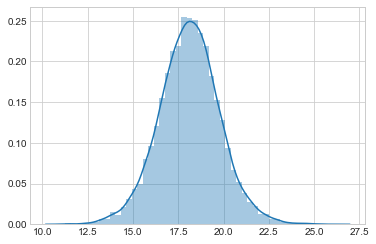Keywords: bayesian | normal-normal model | map | mcmc | Download Notebook
Contents
The Normal Model
A random variable $Y$ is normally distributed with mean $\mu$ and variance $\sigma^2$. Thus its density is given by :
Suppose our model is ${y_1, \ldots, y_n \vert \mu, \sigma^2 } \sim N(\mu, \sigma^2)$ then the likelihood is
We can now write the posterior for this model thus:
Say we have the prior
Now, keeping in mind that $p(\mu, \sigma^2) = p(\mu \vert \sigma^2) p(\sigma^2)$, we will need tp specify the prior on the variance. Our sample estimate is 1, so we can be fairly informative if we consider a half-normal with a standard deviation of 10.
Example of the normal model for $\sigma$ to be sampled.
We have data on the wing length in millimeters of a nine members of a particular species of moth. We wish to make inferences from those measurements on the population mean $\mu$. Other studies show the wing length to be around 19 mm. We also know that the length must be positive. We can choose a prior on $\mu$ that is normal and most of the density is above zero ($\mu=19.5,\tau=10$). This is only a marginally informative prior.
Many bayesians would prefer you choose relatively uninformative priors.
The measurements were: 16.4, 17.0, 17.2, 17.4, 18.2, 18.2, 18.2, 19.9, 20.8 giving $\bar{y}=18.14$.
Y = [16.4, 17.0, 17.2, 17.4, 18.2, 18.2, 18.2, 19.9, 20.8]
#Data Quantities
sig_data = np.std(Y) # sample estimatge of $\sigma$
mu_data = np.mean(Y)
n = len(Y)
print("sigma", sig_data, "mu", mu_data, "n", n)
sigma 1.33092374864 mu 18.1444444444 n 9
# normal prior for mean parameter
# Prior mean
mu_prior = 19.5
# prior std
std_prior = 10
Sampling by code
We now set up code to do metropolis using logs of distributions:
def metropolis(logp, qdraw, stepsize, nsamp, xinit):
samples=np.empty(nsamp)
x_prev = xinit
accepted = 0
for i in range(nsamp):
x_star = qdraw(x_prev, stepsize)
logp_star = logp(x_star)
logp_prev = logp(x_prev)
logpdfratio = logp_star -logp_prev
u = np.random.uniform()
if np.log(u) <= logpdfratio:
samples[i] = x_star
x_prev = x_star
accepted += 1
else:#we always get a sample
samples[i]= x_prev
return samples, accepted
# this code is taken and adapted from https://github.com/fonnesbeck/Bios8366/blob/master/notebooks/Section4_2-MCMC.ipynb
rnorm = np.random.normal
runif = np.random.rand
def metropolis(logp, n_iterations, initial_values, prop_std=[1,1]):
#################################################################
# function to sample using Metropolis
# (assumes proposal distribution is symmetric)
#
# n_iterations: number of iterations
# initial_values: multidimensional start position for our chain
# prop_std: standard deviation for Gaussian proposal distribution
##################################################################
#np.random.seed(seed=1)
n_params = len(initial_values)
# Initial proposal standard deviations
# generates a list of length n_params
#prop_sd = [prop_std]*n_params
prop_sd = prop_std
# Initialize trace for parameters
trace = np.empty((n_iterations+1, n_params))
# Set initial values
trace[0] = initial_values
# Calculate joint posterior for initial values
# the * assigns the arguments of the function according to the list elements
current_prob = logp(*trace[0])
# Initialize acceptance counts
# We can use this to tune our step size
accepted = [0]*n_params
for i in range(n_iterations):
if not i%10000:
print('Iterations left: ', n_iterations-i)
# Grab current parameter values
current_params = trace[i]
# Get current value for parameter j
p = trace[i].copy()
# loop over all dimensions
for j in range(n_params):
# proposed new value
theta = rnorm(current_params[j], prop_sd[j])
# Insert new value
p[j] = theta
# Calculate posterior with proposed value
proposed_prob = logp(*p)
# Log-acceptance rate
logalpha = proposed_prob - current_prob
# Sample a uniform random variate
u = runif()
# Test proposed value
if np.log(u) < logalpha:
# Accept
trace[i+1,j] = theta
current_prob = proposed_prob
accepted[j] += 1
else:
# Stay put
trace[i+1,j] = trace[i,j]
# update p so we search the next dimension according
# to the current result
p[j] = trace[i+1,j]
# return our samples and the number of accepted steps
return trace, accepted
4000 % 1000
0
Remember, that up to normalization, the posterior is the likelihood times the prior. Thus the log of the posterior is the sum of the logs of the likelihood and the prior.
from scipy.stats import norm, halfcauchy
logprior = lambda mu, sigma: norm.logpdf(mu, loc=mu_prior, scale=std_prior) + norm.logpdf(sigma, loc=sig_data, scale=2)
loglike = lambda mu, sigma: np.sum(norm.logpdf(Y, loc=mu, scale=sigma))
logpost = lambda mu, sigma: loglike(mu, sigma) + logprior(mu, sigma)
Now we sample:
x0=[mu_data, sig_data]
p_std = [1.0, 1.0]
nsamps=30000
samps, acc = metropolis(logpost, nsamps, x0, prop_std=p_std)
Iterations left: 30000
Iterations left: 20000
Iterations left: 10000
The acceptance rate is reasonable. You should shoot for somewhere between 20 and 50%.
np.array(acc)/nsamps
array([ 0.50543333, 0.3768 ])
def corrplot(trace, maxlags=50):
plt.acorr(trace-np.mean(trace), normed=True, maxlags=maxlags);
plt.xlim([0, maxlags])
samps[20000::,:].shape
(10001, 2)
sns.jointplot(pd.Series(samps[20000::,0], name="$\mu$"), pd.Series(samps[20000::,1], name="$\sigma$"), alpha=0.02).plot_joint(sns.kdeplot, zorder=0, n_levels=6, alpha=1)
<seaborn.axisgrid.JointGrid at 0x122342b38>
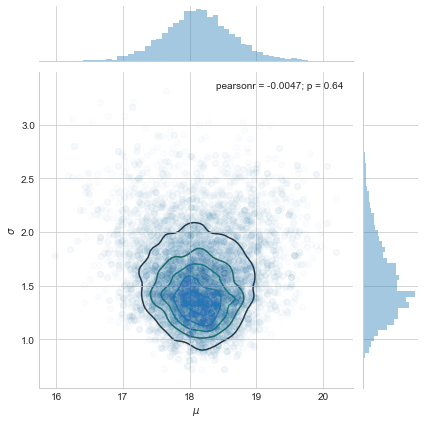
musamps = samps[:,0]
sigsamps = samps[:,1]
plt.plot(musamps[20000::])
[<matplotlib.lines.Line2D at 0x11cd598d0>]
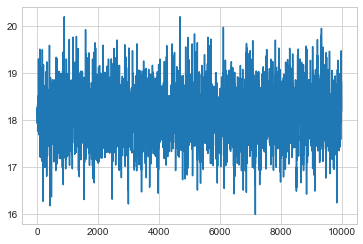
plt.plot(sigsamps[20000::])
[<matplotlib.lines.Line2D at 0x11d203748>]
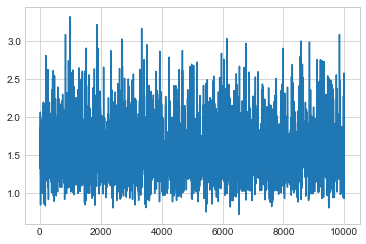
plt.hist(musamps[20000::], bins=50);
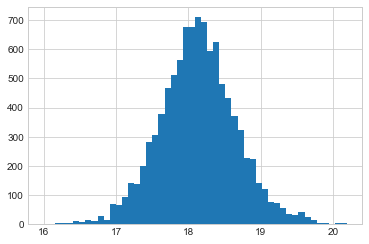
plt.hist(sigsamps[20000::], bins=50);
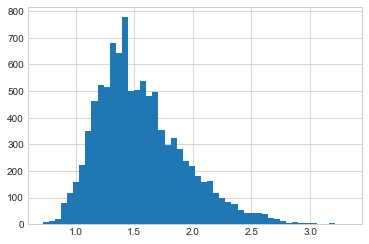
corrplot(musamps[20000::])
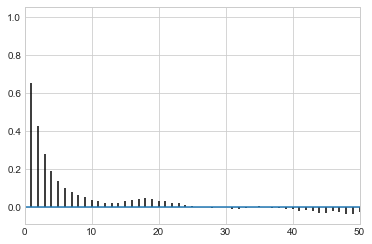
corrplot(sigsamps[20000::])
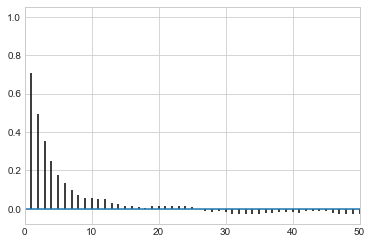
post_pred_func = lambda postmu, postsig: norm.rvs(loc = postmu, scale = postsig)
post_pred_samples = post_pred_func(samps[20000::,0], samps[20000::,1])
sns.distplot(post_pred_samples)
<matplotlib.axes._subplots.AxesSubplot at 0x11fe86f60>
